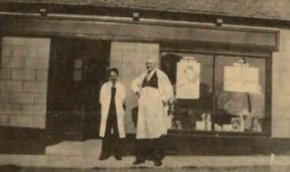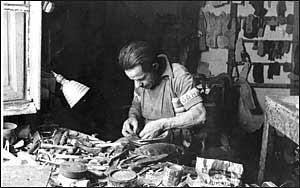Occupations in Heddon from 1800
by Hazel Thompson (as published in 2001)
_Old trade directories only list 'gentry' and businesses.
The main business was farming, some other occupations were:- grocers, blacksmiths, boot and shoe-makers and repairers, and tailors.
The main business was farming, some other occupations were:- grocers, blacksmiths, boot and shoe-makers and repairers, and tailors.
PUBS & TAVERNS
|
_
|
BLACKSMITHS
FARMERS
|
_
The names of some of the farms have changed over the years.
|
_Farmers during the 1800s were Frederick Freeman, John Armstrong, John Atkinson Armstrong [133]
and William Armstrong who all farmed at Bays Leap between 1828 and
1886. Henry Armitage was at Birks East Farm, John Laws at Brecon Hill
Farm, Jonathon Laws [90] at East Heddon Farm, and Mary Laws [90] at Heddon Laws Farm.
During the period 1828 - 1902, Heddon Banks Farm was run at various times by George Armstrong, John Heslop and Isabella Lamb. Mount Pleasant Farm (Heddon Hall) in 1828 belonged to John Moor Bates [94], and West Heddon Farm was run by Robert Howd and Joseph Stoppard.
During the period 1828 - 1902, Heddon Banks Farm was run at various times by George Armstrong, John Heslop and Isabella Lamb. Mount Pleasant Farm (Heddon Hall) in 1828 belonged to John Moor Bates [94], and West Heddon Farm was run by Robert Howd and Joseph Stoppard.
_GROCERS AND SHOPKEEPERS
_In 1894 Elizabeth Sarah Wilkinson was the only female to be elected to
serve on the first Parish Council together with six men from the
village. Daniel Carberry was elected chairman at this meeting.
Between 1828 and 1925 other grocers and shopkeepers are named as Robert Harrison, Charlton Gowans, Alice Gilhespey, Joseph Harrison, Jane Robson, Jane Stobert, John Taylor, William Charlton (Frenchmans Row), William Gibson, Lydia Moore, Mark Reay, Mary Ann Purvis, Mary Ann Waugh, Sarah Hunter, Annie Straughan, and Dorothy Wilkinson.
Unfortunately the directories do not give any indication where the shops were as most of them were in peoples houses. The only ones known today are a sweet shop on Mushroom Row run by Mrs Graham, and Mr Tully sold papers from a house also on Mushroom Row. Bread and teacakes were sold by Mrs Charlton from her house on Station Road and her son also had a van and delivered bread and sweets around Heddon, East Towne Farm and 'Waughs' on Hexham Road, and a Post Office on Clayton Terrace. Mrs Eddy was also known to sell small amounts of necessary goods such as black lead and butter from her house in the Square Yard, one of the Wilkinson family sold sweets from her house at Houghton and Wilkinsons also had East Town Farm.
The first mention of a post office is in 1864 with Mrs Sarah Robson as postmistress, in 1881 Ralph Robson had the post office and in 1902 the post and money order office on Jubilee Terrace was run by John Wright. This became a post office and shop in 1914 and in 1925 the parish council enquired about the installation of a public telephone box at the post office on Clayton Terrace.
After Mr Waugh died the family moved to Haddocks Hole (beside Three Tuns) and Mrs Waugh used to sell lemonade from a window facing on to Military Road to any cyclists or walkers travelling that way. They eventually bought the house on Hexham Road which is now known as the Old Post Office and ran the business of post office and general dealers from there.
The people who lived in Garden House used to sell some of their spare produce to villagers. It was possible to buy 2d of 'potstuff' from them and also a bag of apples or pears for 1d. The horse and cart was used to collect and deliver orders from Throckley Co-op and also a cart came from Wylam Mill to collect orders for flour. Hannah Gibson used to be the carter from Heddon (Carters Cottages?) taking goods from Heddon to Newcastle with her horse and cart and bringing back any packages to be collected from her house by the residents of the village. She lived in the cottages beside the Swan. Another person popular with the men was the bookie. This was in the Square Yard then Hexham Road. All was done on the quiet but everyone knew about it.
Between 1828 and 1925 other grocers and shopkeepers are named as Robert Harrison, Charlton Gowans, Alice Gilhespey, Joseph Harrison, Jane Robson, Jane Stobert, John Taylor, William Charlton (Frenchmans Row), William Gibson, Lydia Moore, Mark Reay, Mary Ann Purvis, Mary Ann Waugh, Sarah Hunter, Annie Straughan, and Dorothy Wilkinson.
Unfortunately the directories do not give any indication where the shops were as most of them were in peoples houses. The only ones known today are a sweet shop on Mushroom Row run by Mrs Graham, and Mr Tully sold papers from a house also on Mushroom Row. Bread and teacakes were sold by Mrs Charlton from her house on Station Road and her son also had a van and delivered bread and sweets around Heddon, East Towne Farm and 'Waughs' on Hexham Road, and a Post Office on Clayton Terrace. Mrs Eddy was also known to sell small amounts of necessary goods such as black lead and butter from her house in the Square Yard, one of the Wilkinson family sold sweets from her house at Houghton and Wilkinsons also had East Town Farm.
The first mention of a post office is in 1864 with Mrs Sarah Robson as postmistress, in 1881 Ralph Robson had the post office and in 1902 the post and money order office on Jubilee Terrace was run by John Wright. This became a post office and shop in 1914 and in 1925 the parish council enquired about the installation of a public telephone box at the post office on Clayton Terrace.
After Mr Waugh died the family moved to Haddocks Hole (beside Three Tuns) and Mrs Waugh used to sell lemonade from a window facing on to Military Road to any cyclists or walkers travelling that way. They eventually bought the house on Hexham Road which is now known as the Old Post Office and ran the business of post office and general dealers from there.
The people who lived in Garden House used to sell some of their spare produce to villagers. It was possible to buy 2d of 'potstuff' from them and also a bag of apples or pears for 1d. The horse and cart was used to collect and deliver orders from Throckley Co-op and also a cart came from Wylam Mill to collect orders for flour. Hannah Gibson used to be the carter from Heddon (Carters Cottages?) taking goods from Heddon to Newcastle with her horse and cart and bringing back any packages to be collected from her house by the residents of the village. She lived in the cottages beside the Swan. Another person popular with the men was the bookie. This was in the Square Yard then Hexham Road. All was done on the quiet but everyone knew about it.
_TAILORS are listed as John Falkes and John Falkous as well as Matthew Hunter,
William Charlton and William Howden. Slight changes in spelling
surnames make it difficult to be certain that you are tracing the
same family.
_SHOEMAKERS
|
_Listed as shoemakers are Thomas Fewters and Robert Futers as well as John Ramsey, John Taylor, Edward Hawkins and Edward Shipley at Frenchmans Row.
From the churchyard tombstone inscriptions we know that there was a shoemaker by the name of Robert Smith who died in 1752 [13]. Mr Westgarth was a COBBLER who had a wooden hut on the corner of the Square Yard and eventually Mr George Clark had his cobblers business on Station Road. |
_STONEMASONS
are listed as George Hunter, George Lawson, William Johnson, Stephen
Lawson, and Robert Hunter, and in 1881 William Jackson is listed as
Stonemason and Grocer.
VICAR
_One of the constant occupations in Heddon from early times was the Vicar.
Their ministry in Heddon lasted from 1 year to 34 years during this time.
- from 1796 the vicar was Thomas Allason,
- 1830 John Alexander Blackett,
- 1848 John Jackson,
- 1850 Michael Maxwell Heron
- 1873 Charles Boulker,
- 1895 Ernest William Walters,
- 1905 William George Pringle,
- 1932 Samuel E.R. Fenning,
Their ministry in Heddon lasted from 1 year to 34 years during this time.
_SCHOOLS
_At the entrance to St. Andrew's Church is a stone seat on each side of
the porch, this represents the first seat of learning in the parish
where in medieval times those who were willing and able to afford it,
would come for instruction from the priest or monks in charge of the
church. The earliest mention in records of a schoolmaster in Heddon
was Walter Salvin in 1656. In 1823 Mrs Bewicke opened a school at
Houghton for the children of Close House and Houghton. In 1828 Charles
Watson was the schoolmaster there. There are records of the academy in
Houghton in 1834 run by John Young and also at Heddon by Jane Hogg.
|
_The school at Heddon was opened in 1852, it was built by local
craftsmen including the masters house, at a cost of £732-4s-7d which was
met by subscriptions from the landed gentry and a grant of £200 and
the deficit of £3 was made up by the vicar giving his fee from the
marriage of Miss Stephenson of Throckley House with Mr George Scott as
Master and he received the vast sum of £55 per annum. There seems to
have been a problem with keeping teachers as they had six in the first 5
years. In 1858 Mr James Phorson was schoolmaster at Heddon with Mrs
Margaret Phorson as schoolmistress. In 1858 Thomas Hopper was
schoolmaster and he is still mentioned in 1864. By 1886 John Edward
Hall was schoolmaster and Miss M. Lomas was schoolmistress. There were
about 133 children attending the school during 1888.
|
_COAL MINING
|
_An early mention of was
in 1784 when it was noted that a pit at Heddon was the first to use
'screening' for coals, seperating the pieces by size. In 1788 a pit
on the south side of Hexham Road between the Great Hill and French
Arms was worked to 30 fathoms. The Margaret pit at Heddon was both a
deep mine and a drift mine. In 1902 it was sold by Cadwaller Bates to
Throckley Coal company and early in the 1930s it was closed. There was
also mining in 1957 when the National Coal Board bought Bays Leap,
Towne House and Heddon Mill for opencast mining.
|
DOCTORS
We can also find from the tombstone inscriptions that there was a Marmaduke Marr who was a HOUSE SURGEON and died in 1869 [72], Robert Stevenson who was a DOCTOR and died in 1828 [95], and William Elliott who was also a DOCTOR and died in 1851 [56].
JOINERS were John Burn [83] and John Robson [114], Mr Duke who was Turkish and lived on Hexham Road next to the vicarage, and there is also, at a later date, Tulip and Murray.
We can also find from the tombstone inscriptions that there was a Marmaduke Marr who was a HOUSE SURGEON and died in 1869 [72], Robert Stevenson who was a DOCTOR and died in 1828 [95], and William Elliott who was also a DOCTOR and died in 1851 [56].
JOINERS were John Burn [83] and John Robson [114], Mr Duke who was Turkish and lived on Hexham Road next to the vicarage, and there is also, at a later date, Tulip and Murray.











